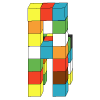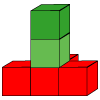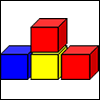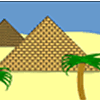Take some ... cubes
Before reading this article, you may like to read Manipulatives in the Primary Classroom which offers research-based guidance about using hands-on equipment in the teaching and learning of mathematics.
Interlocking cubes are a versatile resource which are powerful for modelling the mathematics of problems and are therefore a must-have for all primary classrooms. Unlike, for example, Dienes apparatus or Cuisenaire rods, interlocking cubes have no underlying mathematical structure, so offer us a great deal of flexibility, meaning they can often be used to suit the particular problem in hand. In this article, I will outline four different ways in which cubes can support children in their ability to work mathematically and I will suggest tasks that exemplify each, all of which can be found in our Cubes Feature.
1. Developing conceptual understanding
Cubes have the potential to support understanding of conceptual understanding through helping us model and visualise mathematics.
Creating physical models out of cubes, which almost all our chosen tasks involve, will help learners develop their spatial awareness in a very general sense and, if given opportunities to talk about what they are doing, children will become more fluent in their use of positional and spatial language. In addition, the process of building and pulling apart can support understanding of specific concepts such as surface area and scaling.
Image

Giving children chances to use interlocking cubes to represent numbers will deepen their understanding of number properties and equip them with a mental image to draw upon subsequently. Numbers as Shapes offers visual images for prime numbers and square numbers; the group task Even and Odd gives learners a way of 'seeing' even and odd numbers (as the name suggests!) and Making Sticks encourages children to explore the concept of multiples in a practical way.
2. Developing problem-solving skills
In her article Developing Excellence in Problem Solving with Young Learners, Jennie Pennant suggests that one way in which we can support children in becoming confident and competent problem solvers is by 'explicitly and repeatedly providing children with opportunities to develop key problem-solving skills'. In the tasks we have chosen, interlocking cubes are a useful context in which to encourage development of a number of different problem-solving skills, including working systematically, pattern spotting, generalising and visualising.
Working systematically
Image

Pattern spotting and generalising
Image

Visualising
In section 1 above, we suggested that cubes can help children to visualise mathematical concepts. Visualising is also a useful problem-solving skill but it is perhaps not so well recognised in that context. Specifically giving children opportunities to visualise, as in Building with Cubes, will give you chances to talk about what it means and how it is useful, so that learners become more accustomed to using it themselves as they tackle problems. In Up and Down Staircases, the interactive in the 'Getting started' section may encourage children to try and visualise why the total number of cubes is always a square number.
3. Fluency
Image

Offering children opportunities of consolidation in meaningful contexts is another way to improve fluency. For example, as learners tackle Brush Loads, the act of counting the number of brush loads for each arrangement of cubes means they are constantly practising how to find surface area. This is meaningful because they have the goal of maximising in mind, they are not finding each surface area simply for the sake of it.
4. Reasoning
Image

Chairs and Tables presents a range of starting points and no one 'right' answer, meaning that learners have to reason simply to get started on the task. Even and Odd is a group task, so not only are you reasoning yourself, you are trying to understand the reasoning of other members of your group, all without being able to speak! 3 Blocks Towers and Cubes Here and There involve logical reasoning in explaining how you know that you have found all the solutions. In Building with Cubes, you have to use reasoning to make sense of the information which is given, bit by bit. Numbers as Shapes, Making Sticks, Up and Down Staircases, Brush Loads and Picture a Pyramid ... all demand generalisations, which necessarily involve reasoning.
Interlocking cubes and the new national curriculum in England
Those of us teaching in England are currently (May 2014) in the transition phase between old and new national curricular. The new mathematics national curriculum has three aims relating to problem solving, reasoning and fluency, and as discussed above, using well-chosen tasks which involve cubes can certainly help to achieve all three. It also contains more challenging content compared with the old version, so having mental images to draw upon will really help children as the complexity of challenge develops, and interlocking cubes can play an important role in this respect. (To find out more about the importance of mathematical models and mental images, see the articles From Objects and Images to Mathematical Ideas and Models in Mind.)
And finally ...
You can find many more lower primary activities which make use of interlocking cubes here and further upper primary tasks here. You may also wish to read the short article Many Ideas with a Few Cubes, which was originally written for the Mathematical Association's journal, Equals. It gives a brief overview of a few other cube activities and suggests that they could be used to focus teachers' attention on sharing ideas and precision of arguments.
Here is a PDF version of this article.
